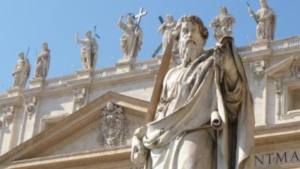Integrating Catholic Identity with Language Arts

Author: John Jiminez
For a Catholic school teacher, there are some terms that come up repeatedly. Two are “integration” and “Catholic identity.” Integration refers to when there is cross-over between subjects in a lesson. For, example, if a class is studying a piece of literature about a period they are learning about in history, that is integration. History is being integrated into language arts instruction.
Catholic identity is pretty self-explanatory, but it is not easy to accomplish. To a Catholic educator, the question is: Outside of direct religion instruction, how do we create a school/classroom that is thoroughly Catholic? There are many elements to this, such as prayer, classroom environment, school culture, and of course, integration. How can we integrate Catholicism into our instruction of math, science, history, language arts?
As educators of Catholic children, whether they are our own children, or we are in a classroom, or a parish, we want children to see being Catholic as the essential element of their identity. They are children of God, and that fact is central to everything they do, and everything else they are. In school, we want them to look at, and evaluate history through the lens of the Gospel of Jesus Christ, and in light of His Life, Death, and Resurrection. When they study science, we want to encourage wonder at uncovering the mysteries of God’s creation.
One way educators can teach children to do this, and integrate Catholic identity into their instruction, is through language arts, especially reading. In first place is literature. We should be very deliberate about providing great works of literature for our children. There are wonderful novels that are explicitly Catholic, or Christian, and others that are more subtle, but put an emphasis on Catholic themes.
Some of the best are works by C.S. Lewis and J.R.R. Tolkien, as well as The Bronze Bow, by Elizabeth George Speare, and Ignatius Press’s series on the saints. To find a good list of grade-appropriate literature, check out Gladys Hunt’s Honey for a Child’s Heart. And, of course, part of the fun is searching out and finding treasures of your own.
Literature is only one part of reading instruction, of course. Often we need to provide short passages; we need to teach children the tools of phonics; we need to teach them basic skills like summarizing, identifying cause and effect, examining characters, etc. Although these elements are part of our literature discussion, it is often helpful to work on them in isolation with shorter passages as well. And, of course, all educators have to figure out how to help struggling readers with unique challenges.
Catholic Brain provides numerous tools that can be useful for these tasks, while integrating Catholic identity into language arts instruction.
Books
Teachers often use educational Web sites to find short stories or passages for their students to read. One that is well worth a look is Catholic Brain’s “Books” section. There, you will find numerous short stories directly from the Bible, or about a Saint, that students can read and discuss.
They can be used for teaching many different skills. Analyze the plot elements or characters in the Parable of the Prodigal Son, for example. Pull out vocabulary to study. Analyze what were the causes of Jonah’s first refusal to preach to the Ninevites, and later his obedience. All the things you might do with a basal reader can be done with the books on Catholic Brain, all while integrating Catholicism into your instruction.
As a bonus, students have the option to listen to the story read aloud to them as they read along. This is one tool that can be used to help struggling readers develop their fluency, as well as to be able to participate in the comprehension activities.
Videos
Another useful tool to help all readers, not just those who are struggling, are the videos. Because there are many stories shared in video format, teachers can study the same elements of a story after watching it, instead of reading it. Watching a video does not substitute the need for reading, to be sure, but it does offer additional opportunities to study literary elements and engage struggling readers or children too young to read.
Catholic Brain has videos of parables, Old and New Testament stories, lives of the Saints, and fun series like Carlos Caterpillar, Brother Francis, and Lukas Storyteller. If using videos is already one of your strategies, this is a useful library of Catholic offerings.
Scripture
Another term often heard among Catholic educators is “Bible literacy.” The Catholic Church is the ultimate Bible Church, and we want our children to be very comfortable with the Scriptures. Besides having an online Bible for children to access, Catholic Brain offers the daily Bible readings in child-friendly language. Not only is this an easy way to provide a short reading practice using the Bible, each day has a quick, five-question quiz that allows you to immediately assess comprehension.
Being a teacher is hard; being a catechist is hard; being a parent is hard. We are constantly looking for learning opportunities for our children, as well as faith-building ones. Making Catholic identity a priority and integrating our Faith into all of our instruction, are keys to helping our children fall in love with the reality that they are children of God and members of His Catholic family.
